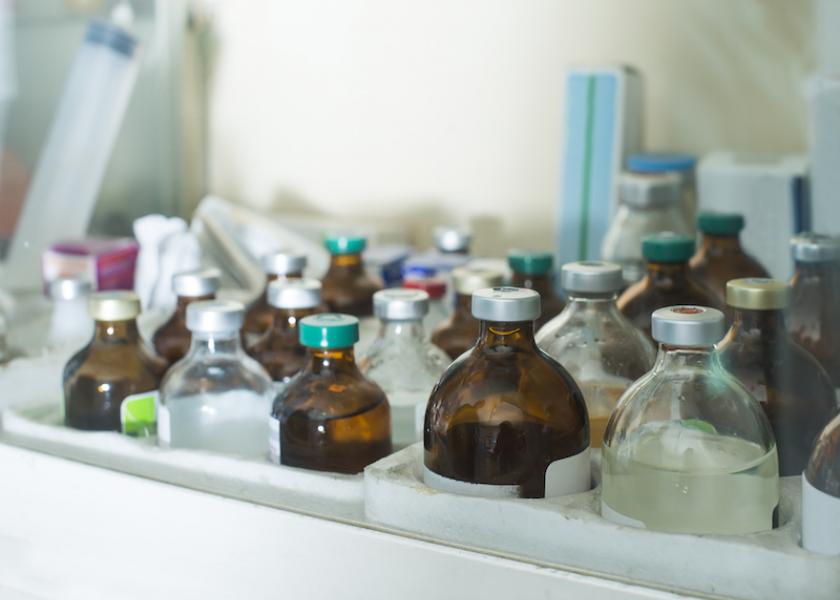Nine Research Grants Focus on Improving Beef and Swine Antibiotic Use

With the goal of optimizing the use of antibiotics in livestock, the International Consortium for Antimicrobial Stewardship in Agriculture (ICASA) has awarded nine grants to develop management strategies that improve judicious antibiotic use in beef cattle and swine, says a recent release.
Investigating novel and potentially high-impact solutions to promote targeted antibiotic use and advance animal health and welfare, the grant-funded projects speak to the need to accelerate antibiotic stewardship research, says Dr. Saharah Moon Chapotin, Foundation for Food and Agriculture Research (FFAR) executive director.
The following grants have been awarded, according to the release:
— Dr. Raghavendra Amachawadi of Kansas State University (KSU) received $125,000 to identify specific bacterial species in cattle liver abscesses beyond the primary species, Fusobacterium necrophorum, and determine their prevalence and involvement in abscess formation, especially in the under-studied hindgut segment of the gastrointestinal tract. This research could help identify new interventions to minimize the occurrence of liver abscesses in cattle. Micronutrients Corporation, Cargill Incorporated and Phibro Animal Health Corporation are contributing additional funding for a total $280,000 investment.
— Dr. Rand Broadway of the USDA Agricultural Research Service (ARS) received $85,700 to develop a minimally invasive model that induces liver abscesses and improves researchers’ ability to study the development and mitigation of the abscesses, while reducing the time necessary to generate enough animals to study. West Texas A&M University (WTAMU), ARS and KSU are contributing additional funding for a total $180,922 investment.
— Dr. Vinicius Machado of Texas Tech University (TTU) received $97,400 to investigate how beef cattle immune systems react throughout the lifecycle of F. necrophorum. Machado’s research is identifying potential pathways in which the bacteria subvert the hosts’ defenses during the development of liver abscess to lay the foundation for the formation of novel approaches, such as alternative drugs, that can potentially replace antimicrobials in liver abscess control and prevention strategies. TTU is contributing additional funding for a total $195,140 investment.
— Dr. Kristen Hales of TTU received $125,000 to investigate the gastrointestinal location, concentration and movement of F. necrophorum and Salmonella enterica, as well as the other organisms that live in the intestines of cattle with liver abscesses. This first phase of Hales’ research will inform a methodology to reduce F. necrophorum through a direct-fed microbial. TTU is contributing additional funding for a total $250,000 investment.
— Dr. Kendall Samuelson of WTAMU received $266,748 to develop a unique, repeatable method that induces liver abscesses in feedlot cattle to further investigate the relationship between acids in the rumen, the first chamber of a cow’s four-chamber stomach, and liver abscesses. Samuelson is also developing a scoring system to evaluate rumen health, updating the current liver scoring system to characterize liver abscess prevalence and developing a benchmark between these factors for future study. WTAMU and Cactus Feeders are contributing additional funding for a total $542,475 investment.
ICASA also funded a project that improves the collection, analysis and reporting of feedlot antibiotic usage data, which can potentially impact how corporations and regulatory agencies formulate policies on antimicrobial use in beef cattle.
— Dr. Michael Apley of KSU received $200,000 to develop a sustainable, practical system for individual beef producers to evaluate and report their antimicrobial usage in context of others across the beef feedlot industry. KSU is contributing additional funding for a total $400,022 investment.
Additionally, ICASA awarded three grants to develop management strategies in the prevention and treatment of Mycoplasma hyosynoviae (M. hyosynoviae) in swine. This ubiquitous bacterium causes respiratory disease and lameness in pigs, contributing to economic loss and decreased animal welfare, and is a major driver of antibiotic use in swine production.
— Dr. Tim Johnson from Purdue University College of Agriculture received $140,001 to investigate using fecal microbiota, or stool, transplants to reduce post-weaning diarrhea and antibiotic use in swine. Post-weaning diarrhea is caused when bacteria invade the gut, which becomes weakened from the diet change, transportation and change in environment that occurs during weaning. Johnson is administering the fecal transplants though a feed amendment with freeze-dried fecal microbiota, a less labor-intensive method than traditional oral gavage and better suited for commercial settings. If effective, the results could be optimized for other animal species like poultry and cattle and be developed into proprietary feed additive-type technologies by the animal health industry. Purdue University and the National Pork Board are contributing additional funding for a total $311,354 investment.
— Dr. Meghann Pierdon from the University of Pennsylvania (Penn) School of Veterinary Medicine received $127,703 to identify factors that cause swine lameness to determine whether management factors like floor type, pen size and nutrition underlie common lameness problems. Little is known about the incidence and causes of lameness in swine. If lameness is caused by non-bacterial factors, alternative methods of prevention can be identified, reducing antibiotic usage. Penn and PIC, are contributing additional funding for a total $268,493 investment.
— Dr. Maria Pieters from University of Minnesota (UMN) College of Veterinary Medicine received $149,748 to identify the optimal time for vaccine application against M. hyosynoviae, which will result in significant prevention of lameness development in grow-finish swine and translate into reduced use of antibiotics for disease control. Newport Laboratories, Tyson Foods, Pipestone Veterinary Services, UMN and Boehringer Ingelheim are contributing additional funding for a total $359,618 investment.







